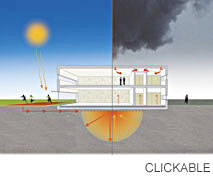Ground Source Heat Pump Systems Design
ICAX IHT™ systems are designed to give optimum performance for the capital outlay for each ground source heat pump project. In order to ensure that thermal balance is achieved, ICAX performs a full thermal modelling exercise as part of the turnkey supply of IHT™.
The optimum efficiency of a building design depends on a range of criteria and design decisions made by the building project team. This includes orientation, shading, material choice and component specification, thermal mass, environmental systems including ventilation strategies, building use and management. All of these criteria affect the heating and cooling and hot water loads of a building.
Once the building loads are established, ICAX defines the optimum size and type of ICAX Solar Collectors, the ICAX Thermalbank store for each project and the capacity of the heat pumps to be used. The modelling takes into account local geology as part of the design package for IHT.
Other Thermal inputs, such as excess heat from flat plate solar collectors, or waste heat form chilling plant, may also be an important part of the overall thermal balance of the project, and these will be accounted for in the modelling.
ICAX’s thermal modelling expertise is based on over a decade of modelling experience, and possibly the most comprehensive site data for ground heat movement in the world, drawn from our own projects.

Where ground source energy is designed to provide space heating in winter
IHT can be used to provide space heating in winter by transferring heat from the ground using a ground source heat pump connected to a ground loop heat exchanger. As heat is extracted from the ground the ground temperature falls – there is a danger that, if there is no active mechanism to replace the heat extracted, the ground will freeze and the heat pump will "lock out". The risk is high where a gshp is extracting too much heat from a small ground loop: an unsustainable heating system. The thermal balance of the ground can be restored in a Seasonal Heat Transfer system if an asphalt heat collector is used in summer to transfer heat into the ground and achieve an overall thermal balance across the seasons. The additional cost of providing solar heat collection in summer may allow a saving in the size and cost of the ground loop (as part of the effect of restoring balance to the system).
Thought needs to be applied as to whether the IHT system is to be designed to provide the full heating load across the winter, or whether the intention is to provide a base load of, say, 70% of the peak load. 70% of the peak load would provide the heating requirement for most days in the winter, but consideration would need to be given to meeting the occasional back up heating load. How large is the hot water demand for the building? Should the system be sized to meet the domestic hot water requirement as well as the space heating load?
The capital costs of providing these alternatives need to be examined in the light of the annual savings to be achieved, and the carbon saving objectives. The financial benefit of the Renewable Heat Incentive should be taken into account, both for heat provided by the gshp and heat collected by solar thermal panels for domestic hot water.
An IHT system meeting the full space heating loads in a gas free system may allow the cost of providing a gas installation to the site to be saved.
Where ground source energy is designed to provide cooling in summer
IHT can be used to provide comfort cooling in summer by using IHT to allow heat to escape from the building to the ground. Stronger cooling can be provided by reversing the heat pumps and actively transferring heat from the building to the (relatively) cold ground. As heat is extracted to the ground the ground temperature rises. If there is no active mechanism to allow the heat to escape from the ground the ground temperature will rise until the point where the heat exchange with the ground becomes uneconomic. The risk is high where a heat pump is transferring too much heat from the building to a small ground loop: an unsustainable cooling system. The thermal balance of the ground can be restored in an Seasonal Heat Transfer system if an asphalt heat rejector is used to release heat from the ground in wintertime (or on cold summer nights) in order to achieve a thermal balance across the seasons. The additional cost of providing heat rejection will allow a saving in the size and cost of the ground loop.
The capital costs of providing these alternatives need to be examined in the light of the annual savings to be achieved, and the carbon saving objectives.
Where ground source energy is designed to provide heating in winter and cooling in summer
Where IHT is used to provide heating in winter and cooling in summer there is still the same need to calculate the heating loads and cooling loads to ensure that the heat taken from the ground in winter matches the heat returned to the ground in summer. Paradoxically this is easier to achieve when the IHT system is designed to provide both heating in winter and cooling in summer. In older systems heat is provided by burning carbon fuels in winter and sending large amounts of electricity through chillers in summer – expensive in cash and carbon in both seasons.
An IHT system can provide both heating in winter and cooling in summer by using one integrated system to store the excess heat collected in Thermalbanks in summer – and recycling that same heat from the ground up to the building in winter.
IHT provides a low carbon footprint – from a system which has a low physical footprint.
Variations in ground source energy systems design
As every building is different, there are variations on the basic elements of Heat Capture, Heat Storage and Heat Distribution to meet different locations, different use patterns and differing views from clients on architectural choices:
Heat Capture
IHT will normally capture summer heat from an Asphalt Solar Collector. If there is no suitable road, car park or playground to capture heat from, then heat can be captured from a flat roof if the architects plan to install one, or from a Solar Roof if the plans include a pitched roof. Heat can also be captured from within a building using fan coil units or from an underfloor piping array as a by product of an IHT cooling system, or from standard roof mounted chillers if air conditioning is being employed.
Heat Storage
IHT will normally store summer heat in a horizontal Thermalbank beneath the insulated foundation of a new building. This technique is not appropriate for an existing building, where a very large capacity is required, or where there is a large cooling load to be met. In these circumstances IHT uses a vertical Thermalbank in a borehole field.
Heat Distribution
IHT will normally use underfloor heating to distribute heat within a building. Alternative choices include fan coil units, TermoDeck or air handling units.
Seasonal Heat Storage
Whatever the variations ICAX would like to be involved in the projects at the earliest stage to help ensure the optimum results can be obtained by careful design. Thermal modelling should be engaged at an early stage to ensure that a long term sustainable thermal balance can be achieved.
Good design is critical to achieving high performance from ground source heat pump systems.
Gas free heating
Interseasonal heat transfer allows of design of gas free heating and cooling systems. There is no gas "back-up boiler" at Suffolk One College or at Merton's Intergenerational Centre.
See also: Ground Source Heat Pumps.



